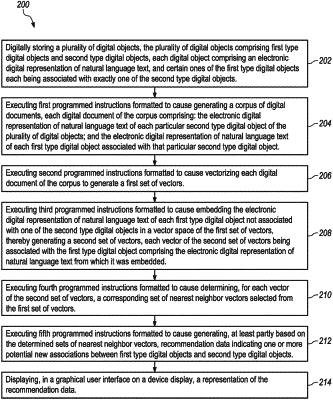| CPC G06F 40/284 (2020.01) [G06F 3/14 (2013.01); G06F 16/3329 (2019.01)] | 18 Claims |

|
1. A computer-implemented method, comprising:
digitally storing a plurality of digital objects comprising first type digital objects and second type digital objects, each digital object comprising an electronic digital representation of natural language text;
generating a corpus of digital documents, each digital document of the corpus comprising:
the electronic digital representation of natural language text of each particular second type digital object of the plurality of digital objects; and
the electronic digital representation of natural language text of each first type digital object associated with that particular second type digital object;
vectorizing each digital document of the corpus to generate a first set of vectors;
embedding the electronic digital representation of natural language text of each first type digital object not associated with one of the second type digital objects in a vector space of the first set of vectors, thereby generating a second set of vectors, each vector of the second set of vectors being associated with each first type digital object comprising the electronic digital representation of natural language text from which it was embedded;
determining, for each vector of the second set of vectors, a corresponding set of nearest neighbor vectors selected from the first set of vectors;
generating, at least partly based on the determined sets of nearest neighbor vectors, recommendation data indicating one or more potential new associations between first type digital objects and second type digital objects; and
displaying, in a graphical user interface on a device display, a representation of the recommendation data.
|